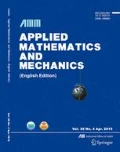Abstract
The immersed boundary method is an effective technique for modeling and simulating fluid-structure interactions especially in the area of biomechanics. This paper analyzes the accuracy of the immersed boundary method. The procedure contains two parts, i.e., the code verification and the accuracy analysis. The code verification provides the confidence that the code used is free of mistakes, and the accuracy analysis gives the order of accuracy of the immersed boundary method. The method of manufactured solutions is taken as a means for both parts. In the first part, the numerical code employs a second-order discretization scheme, i.e., it has second-order accuracy in theory. It matches the calculated order of accuracy obtained in the numerical calculation for all variables. This means that the code contains no mistake, which is a premise of the subsequent work. The second part introduces a jump in the manufactured solution for the pressure and adds the corresponding singular forcing terms in the momentum equations. By analyzing the discretization errors, the accuracy of the immersed boundary method is proven to be first order even though the discretization scheme is second order. It has been found that the coarser mesh may not be sensitive enough to capture the influence of the immersed boundary, and the refinement on the Lagrangian markers barely has any effect on the numerical calculation.
Similar content being viewed by others
References
Peskin, C. S. Numerical analysis of blood flow in the heart. J. Comput. Phys. 25, 220–252 (1977)
Peskin, C. S. and McQueen, D. M. A three-dimensional computational method for blood flow in the heart, 1, immersed elastic fibers in a viscous incompressible fluid. J. Comput. Phys. 81, 372–405 (1989)
Dillion, R., Fauci, L. J., and Gaver, D. A microscale model of bacteria swimming, chemotaxis, and substrate transport. J. Theor. Biol. 177, 325–340 (1995)
Fauci, L. J. and McDonald, A. Sperm motility in the presence of boundaries. Bull. Math. Biol. 57, 679–699 (1995)
Fauci, L. J. and Peskin, C. S. A computational model of aquatic animal locomotion. J. Comput. Phys. 77, 85–108 (1988)
Bottino, D. C. Modeling viscoelastic networks and cell deformation in the context of the immersed boundary method. J. Comput. Phys. 147, 86–113 (1998)
Fogelson, A. L. Continumm models of platelet aggregation: formulation and mechanical properties. SIAM J. Appl. Math. 52, 1089–1110 (1992)
Fauci, L. J. and Fogelson, A. L. Truncated Newton’s methods and the modeling of complex immersed elastic structures. Comm. Pure Appl. Math. 46, 787–818 (1993)
Eggleton, C. D. and Popel, A. S. Large deformation of red blood cell ghosts in a simple shear flow. Phys. Fluids 10, 1834–1845 (1998)
Tu, C. and Peskin, C. S. Stability and instability in the computation of flows with moving immersed boundaries: a comparison of three methods. SIAM J. Sci. Stat. Comput. 13(6), 1361–1376 (1992)
Stockie, J. M. and Wetton, B. R. Analysis of stiffness in the immersed boundary method and implications for time-stepping schemes. J. Comput. Phys. 154, 41–64 (1999)
Stockie, J. M. and Wetton, B. R. Stability analysis for the immersed fiber problem. SIAM J. Appl. Math. 55, 1577–1591 (1995)
Gong, Z. X., Huang, H. X., and Lu, C. J. Stability analysis of the immersed boundary method for a two-dimensional membrane with bending rigidity. Commun. Comput. Phys. 3(3), 704–723 (2008)
Beyer, R. P. and LeVeque, R. J. Analysis of a one-dimensional model for the immersed boundary method. SIAM J. Numer. Anal. 29, 332–364 (1992)
Lai, M. C. and Peskin, C. S. An immersed boundary method with formal second-order accuracy and reduced numerical viscosity. J. Comput. Phys. 160, 705–719 (2000)
Griffith, B. E. and Peskin, C. S. On the order of accuracy of the immersed boundary method: higher order convergence rates for sufficiently smooth problems. J. Comput. Phys. 208, 75–105 (2005)
Lai, M. C. Simulations of the Flow Past an Array of Circular Cylinders as a Test of the Immersed Boundary Method, Ph. D. dissertation, Courant Institute of Mathematical Sciences, New York University (1998)
LeVeque, R. J. and Li, Z. The immersed interface method for elliptic equations with discontinuous coefficients and singular sources. SIAM J. Numer. Anal. 31, 1019–1044 (1994)
Steinberg, S. and Roache, P. J. Symbolic manipulation and computation fluid dynamics. J. Comput. Phys. 57(2), 251–284 (1985)
Roache, P. J. Verification and Validation in Computational Science and Engineering, Hermosa Publishers, Albuquerque, New Mexico (1998)
Roache, P. J. Code verification by the method of manufactured solutions. J. Fluids Eng. 124(1), 4–10 (2002)
Oberkampf, W. L. and Trucano, T. G. Validation methodology in computational fluid dynamics. AIAA Fluids 2000 Conference, Denver, Colorado, 2000–2549 (2000)
Oberkampf, W. L. and Trucano, T. G. Verification and validation in computational fluid dynamics. AIAA Progress in Aerospace Sciences 38(3), 209–272 (2002)
Roy, C. J., Nelson, C. C., Smith, T. M., and Ober, C. C. Verification of Euler/Navier-Stokes codes using the method of manufactured solutions. Int. J. Numer. Mech. Fluids 44, 599–620 (2004)
Bond, R. B., Ober, C. C., and Knupp, P. M. A manufactured solution for verifying CFD boundary conditions, part III. 36th AIAA Fluid Dynamics Conference, Vol. 3, San Francisco, California, USA, 1966–1982 (2006)
Brunner, T. A. Development of a grey nonlinear thermal radiation diffusion verification problem. Trans. Am. Nucl. Soc. 95, 876–878 (2006)
Eca, L., Hoekstra, M., Hay, A., and Pelletier, D. On the construction of manufactured solutions for one- and two-equation eddy-viscosity models. Int. J. Num. Mech. Fluids 54(2), 119–154 (2007)
Tremblay, D., Etienne, S., and Pelletier, D. Code verification and the method of manufactured solutions for fluid-structure interaction problems. 36th AIAA Fluid Dynamics Conference, Vol. 2, San Francisco, California, USA, 882–892 (2006)
Peskin, C. S. The immersed boundary method. Acta Numerica 11, 1–39 (2002)
Author information
Authors and Affiliations
Corresponding author
Additional information
Contributed by Chuan-jing LU
Project supported by the National Natural Science Foundation of China (No. 10472070)
Rights and permissions
About this article
Cite this article
Gong, Zx., Lu, Cj. & Huang, Hx. Accuracy analysis of immersed boundary method using method of manufactured solutions. Appl. Math. Mech.-Engl. Ed. 31, 1197–1208 (2010). https://doi.org/10.1007/s10483-010-1353-x
Received:
Revised:
Published:
Issue Date:
DOI: https://doi.org/10.1007/s10483-010-1353-x




